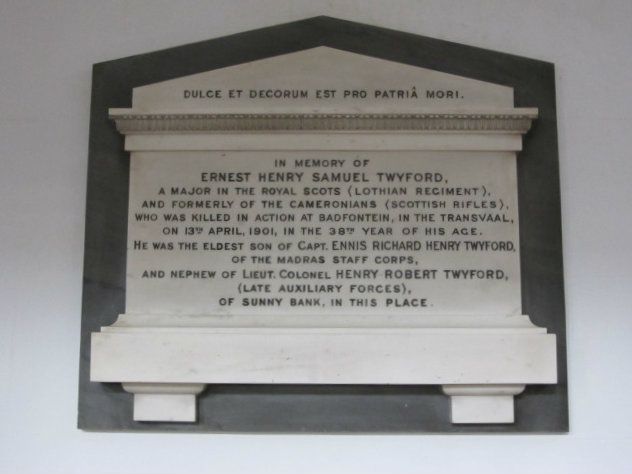His medals were sold in 1999 for £5000.
The catalogue entry read:
DSO VR
IGS 1854 (1) Chin-Lushai 1889-90 (Lieutt., 2d. Bn. Sco. Rif.)
QSA (6) CC TH OFS RoL Tr 01 (Major, D.S.O., Sco. Rif.)
Ernest Henry Samuel Twyford was born on 28 October 1863, and joined the Scottish Rifles in December 1883, as 2nd Lieutenant. He served in India with the Chin-Lushai Expeditionary Force, as Transport Officer, in 1889, receiving the medal with clasp (unique to the Scottish Rifles). In the South African War he was present with the 2nd Battalion, Scottish Rifles, in the Natal Field Force. He was present at the battle of Colenso, the engagements at Spion Kop and Vaal Krantz, in the operations on the Tugela Heights from 14-17 February, including the fighting at Pieter’s Hill (wounded) and the relief of Ladysmith (Mentioned in Despatches and awarded the D.S.O.).
The Scottish Rifles played a distinguished part in the disastrous action at Spion Kop. This now celebrated hill had been seized by the Lancashire Brigade on the night of the 22nd January, 1901, and on the following day the Scottish Rifles were sent up to reinforce them. On a narrow plateau over 3,000 troops were enduring a terrific fire from the surrounding Boer positions which the nature of the ground gave them little chance of avoiding or retaliating. Shells pitched among them, it is stated, at the rate of seven a minute, but they held grimly on throughout the long day. Before night came nearly 1,300 British troops had been killed or wounded in this narrow space, and it was then decided to abandon this costly position. Exhausted and parched with thirst, but with no haste or panic, the survivors marched down from the fatal hill, conscious of having successfully endured a test such as seldom has fallen to the lot of the British Army.
Twyford was mentioned in Sir C. Warren’s despatch of the 1st February in the following terms: ‘Major Twyford was in the most advanced position with his company, and rendered valuable assistance after the death of Major Strong in conducting an orderly retreat from the hill after much devastation.’ Whilst conducting his regiment down the hill, Major Twyford was met by an officer of the staff, Captain H. Phillips, who, according to the Times History of the War in South Africa 1899-1902, ‘... at once stopped the retirement and urged Major Twyford to take his men up the hill again. Twyford agreed to do so if ammunition and water could be got up.’ In the event, Phillips’ orders were countermanded by higher authority. It is probable that Twyford received the D.S.O. for his services at Spion Kop.
Undaunted by the failure of the Spion Kop operations, a few days later found the Scottish Rifles gathered with the other units of their brigade in front of the Boer positions at Vaal Kranz, awaiting the order to advance. Vaal Kranz was an isolated hill, the possession of which it was hoped would have turned the Boer position. In full daylight the brigade advanced to the attack under a rain of bullets. Taking advantage of all available cover, but with a spirit that nothing could check, the Scottish Rifles and their comrades climbed to the summit, and swept the Boers off the hill at the point of the bayonet. Hasty entrenchments were made, and in spite of a severe cross fire, and a counter-attack by the Boers, the brigade held the hill until relieved by General Hildyard’s Brigade.
Vaal Kranz, however, did not prove to be the key to open the road to Ladysmith, and it was subsequently abandoned, and still another effort was called for. These further operations culminated in the battle of Pieter’s Hill on the 27th February, 1900, and before the furious charges of the Scottish Rifles and others, the Boers gave way, and, with a loss of 500 men, they fled northwards, leaving at last a clear way to Ladysmith. Twyford was amongst those wounded in this action.
In recognition of his services in Natal, Twyford was promoted to second-in-command of the Royal Scots, who, in April 1901, were at Machadodorp. Whilst on his way to join the regiment, Major Twyford, with an escort of seven cavalrymen, was attacked in the Badfontein Valley on the 13th April by Jan De Beer’s commando. After a gallant fight from a ruined farmhouse, the Boers closed on them in overwhelming forces. Major Twyford was called upon to surrender; he refused to do so, and continued to fire his rifle until he was shot down and killed.


